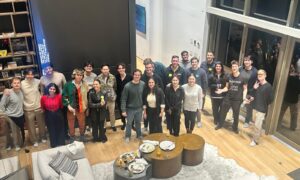An award-winning IT project manager and published researcher shares practical strategies for building automation frameworks that deliver real-world results
In 2025, automation is a baseline expectation. But turning automation into lasting, scalable impact, besides the right tools, demands structure, clarity, and the kind of operational thinking that’s often invisible behind the scenes. In Deloitte’s annual Tech Trends report, artificial intelligence is identified as a foundational element in modern enterprise operations. As it states, “AI is the common thread of nearly every trend. Moving forward, it will be part of the substructure of everything we do.”
This underscores the critical importance of integrating AI and automation into business processes, a domain where Ievgenii Lysenko has made significant strides. As an IT Project Manager and Business Analyst at PwC, the world’s largest and most respected professional services firm, operating in over 140 countries with clients like Goldman Sachs and IBM, he led complex automation initiatives that spanned multiple countries and regulatory environments. He introduced new validation frameworks, streamlined cross-team collaboration, and developed internal systems that made operations more accurate, efficient, and responsive to business needs. His approach helped transform scattered, manual processes into coordinated workflows that could grow with the company.
A published researcher with over 10 scientific articles, an international award-winning automation strategist, named Best IT Project Manager by the 2024 Best Business Awards, and a fellow of Hackathon Raptors — a selective network of top engineers — Ievgenii brings academic rigor and technical depth into real-world transformation.
In this interview, he breaks down how structured thinking turns automation into lasting impact and what leaders can learn from systems that scale.
Ievgenii, as AI and automation become foundational to enterprise strategy, many companies are still figuring out how to translate that vision into practical, measurable outcomes. From your perspective, what makes this transition so challenging in real-world organizations?
That gap between strategy and execution is very real. In many organizations, automation is treated as a technical add-on, not a structural shift. They focus on tools before understanding the processes those tools are meant to support. But without a clear logic, documentation, and validation framework behind it, automation often becomes chaotic, or worse, invisible.
Another challenge is cultural. People are used to manual processes and tend to trust what they can control directly. So even when automation is technically sound, it won’t succeed unless teams understand how it fits into their workflow and why it adds value.
In my experience, the turning point comes when automation is not just “deployed” but operationalized. Or when it’s tied to real outcomes like time saved, errors reduced, or processes scaled. That’s when people start trusting it. And that trust has to be earned through structure, not shortcuts.
Is that the kind of structural thinking you applied at PwC, where your approach enabled the adaptation of a unified automation tool to the regulatory requirements of different countries, while maintaining consistency and quality across diverse contexts? What exactly made that system so scalable?
Yes, exactly. I joined the project in its early phase, when it was just beginning to expand. Over time, the team scaled it to support automation in more than 25 countries, each with its own regulatory environment. But at that early stage, there was no established quality assurance process at the time. I started by reviewing every version of the tool myself to ensure it aligned with the complex business logic of each jurisdiction.
As the workload grew, I realized we needed more structure. I proposed and launched a compliance team and designed a two-level review process: the first check by compliance specialists, and a second review by me. This helped ensure both consistency and accuracy.
Beyond that, I created centralized systems for version tracking, detailed checklists for validation, and performance monitoring tools. These weren’t just add-ons — they became part of the process itself. That’s what made the system scalable: we weren’t just solving problems; we were building infrastructure to prevent them.
Because of that, error rates dropped significantly, and we were able to take on more country-specific requests — all without increasing the size of the team.
That focus on designing replicable systems didn’t stop with tax tools. You also created an automated onboarding system at PwC that immediately saved 15 hours monthly in one office, and is now being adapted across five countries. How did that project come about, and what lesson does it offer for global tech teams?
That one came from a growing pain point that was noticed right away: onboarding was manual and inconsistent. A significant amount of time was being spent on repetitive onboarding tasks — scheduling meetings, sending reminders, tracking steps manually. It wasn’t just inefficient; it was error-prone and stressful for everyone involved.
So I led the development of an internal automation system. It automatically schedules welcome meetings, sends onboarding emails at the right time, reminds key people of upcoming milestones, and tracks progress through the checklist. And that’s just the base layer, as new features are still being added.
What this showed me is that if you solve a real pain point with a clear, measurable result, the solution will spread. But only if it’s structured well enough to scale.
Outside of corporate work, you’ve published over 10 scientific papers, including one in IEEE — a leading authority in engineering and computing research. How does this academic foundation support the systems you’ve built in industry?
Academic work taught me how to turn complexity into clarity. When you write a scientific paper, especially for platforms like IEEE, you’re forced to take an abstract idea, test it rigorously, and communicate it with precision. That discipline translates directly into the systems I build in industry—whether it’s designing an automation framework or evaluating a project proposal. I don’t just look for what works; I look for what holds up under scrutiny.
It also trained me to think structurally. In research, there’s no room for vague logic—you need a clear hypothesis, method, and conclusion. That same mindset helps me build solutions that don’t just solve today’s problem, but scale and adapt for tomorrow.
You were also recognized as Best IT Project Manager by the 2024 Best Business Awards, and joined the Hackathon Raptors Fellowship, which includes top engineers from Google, Amazon, and Meta. What do these recognitions represent to you at this point in your career?
Receiving that recognition meant a lot because it highlighted the impact of the work I’ve done behind the scenes—designing systems, improving processes, and ensuring that teams can deliver at scale without burning out. It wasn’t about a single project, but about consistently driving value through structure and clarity. For someone who thrives on operational problem-solving, it was a meaningful acknowledgment that this kind of quiet leadership matters.
Earlier in your career, you managed development teams on platforms like Upwork, delivered commercial products solo, and worked as a front-end engineer at Delphi Software. How has this mix of hands-on and leadership experience influenced your management style?
It gave me empathy. I know what it’s like to write production code under a deadline, to manage client expectations, and to pivot on a weekend because something broke in testing. So when I lead now, I don’t just delegate. I try to protect developers’ space to think and build well.
That early freelance experience, especially, taught me ownership. You don’t get to say “this isn’t my problem.” Everything is your problem. And that mindset has helped me lead teams more effectively, especially in environments where priorities shift quickly.
Looking ahead, what areas of innovation are you most focused on? And what kind of challenges are you hoping to solve next?
I’m most interested in solving problems at the intersection of automation, decision-making, and usability. Too often, systems are either powerful but hard to use, or easy to use but too rigid. I want to keep building solutions that don’t just automate tasks, but elevate how people think and collaborate.
In the near future, I plan to deepen my expertise in AI-assisted systems for internal operations and knowledge management. Now I want to go beyond removing inefficiencies. Frankly, I want to create tools that actively enhance how teams make decisions and manage knowledge. If we can give people better tools to see what matters, and automate the rest, that’s real impact.





























